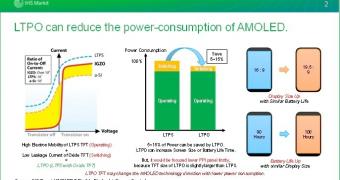One of the biggest drawbacks of smartphones, in general, and iPhones, in particular, is battery life, with manufacturers going for different approaches in an attempt to offer more juice per charge.
While Samsung has substantially increased battery capacity on the recently-released Galaxy Note 9, Apple might be going for another method to improve battery life, and it’s all thanks to its transition to OLED screens.
A report from IHS Markit indicates that the Cupertino-based tech giant is currently considering a substantial upgrade to its display tech that would essentially come down to replacing low-temperature polysilicon thin-film transistors (LTPS TFT) with low-temperature polycrystalline oxide (LTPO) backplanes.
While it may sound like rocket science for many, such a change would essentially allow Apple to better optimize display power usage, technically setting various parameters in a more effective manner.
According to the cited source, battery life could be improved by as much as 15 percent, which is basically enough for an iPhone to get you through the day without any worries regardless of usage patterns.
Reducing reliance on third-party suppliers
By the looks of things, Apple hopes it can do the whole thing all alone, and there’s a good reason for this. The company wants to reduce reliance on third-party suppliers as much as possible, and developing the new technology on its own means Apple has full control over more stages in the designing process.
But at the same time, this new technology cannot be finalized overnight, and IHS Markit says the resolution of the screen and the bigger complexity would be the main challenges.
“The photomask, in LTPO is 20% more than that of LTPS, which is already 100% more than that of amorphous silicon (a-Si) TFT. A bigger photomask entails greater complexity, which then requires bigger equipment and, thus, investment,” it says.
Apple is expected to make the full switch to OLED screens in 2019 the earliest, with some analysts predicting that the company would keep an LCD model around for at least one more year after the 2018 generation.

 14 DAY TRIAL //
14 DAY TRIAL //